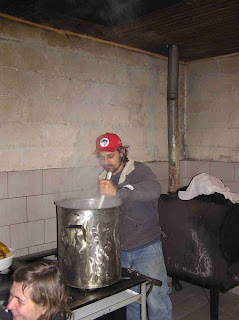So here are a few photos from my time here at the school. It's unlike the 17th of April settlement that I was at previously in the north, which is an agrovilla, basically like a centralized village. This is more spread out, there is no real village per-se, rather each house is seperated by about 15 hectares, and the school is between two settlements. The school itself is very different from the one I was at up north. By different I mean not only the physical structure of the buildings, which you will see in the next photos, but the pedagogy, and educational identity are very different as well. As the photos might show, there is a much stronger educational identity related to the movement itself here than in the north. Additionally, the formal agroecology curricula is much stronger here than in the north. This is what I was expecting, but is very interesting to see how it is manifested and think about the implications for cultural identity, agricultural practices, and formal and informal processes of landscape change.
SO the first picture is on the way to the school. Matheus, the director who wears innumerable hats here, picked me up after I took an overnight bus to the state of Santa Catarina. We stopped the car to look at the school from the top of the hill, where Matheus proudly told me that the land of the school, 34 hectares had more native forest than any of the surrounding land....a trend?

As I mentioned, the physical structure of the school here evidences the political identity of the movement, much stronger than the relatively blank walls of the school up north. This mosaic and the mural that follows are the product of a collaboration between Dan, Manoela, and the school a number of years ago (they are my connection to this particular school). There work with the students is amazing,and continues to shine on.



As these images show...it's always MST time at this school (I know a horrible pun...)

Now in terms of actual pedagogy, and its effects, we see images like these: students taking seeds home from the school's stockpile. The school works on an interesting block system, the students spend 45 days living at the school, and then about the same period of time working at home, putting the lessons learned in the ground...literally, they then return and continue the process.

and other examples, such as this agricultural mandala that is part of the school's teaching garden, very agroecology, very different than the kind of educational landscape I witnessed previously.

and to end with a few funny pictures: It's been raining and very very cold here (in the 40s probably at night)considering the houses are basically plywood without insulation or heating...a good warm drink is much welcomed. Here is a photo of Matheus stirring the witches brew in a giant pot...

and then having an assistant light it on fire to burn off the alcohol!!!

and a parting shot of the seedlings in the nursery: these are a native species of pine that is very beautiful when it grows old....very elegant...another step in the transformation of this cultural landscape.

ok, and a last photo. This is a picture taken from within one of the classrooms. The rough translation is "We are the multiplication of struggles; like the ground multiplies planted grain, we are planting and harvesting, we are a ray of hope"

No comments:
Post a Comment